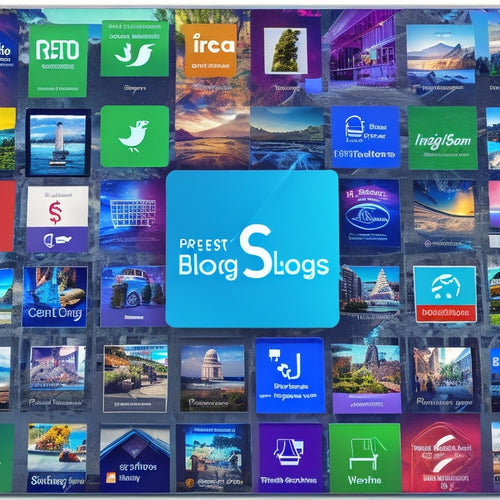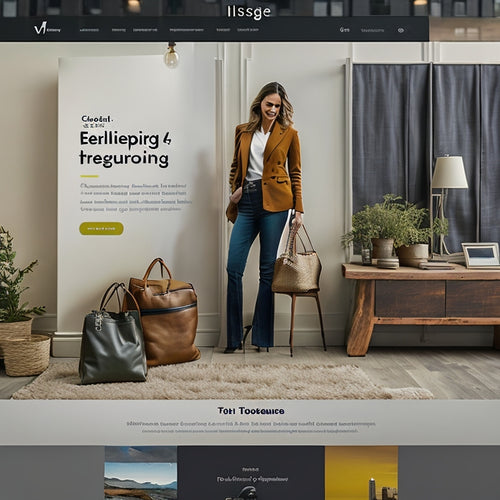
5 Best Strategies to Retain Ecommerce Customers
Share
You can boost your ecommerce store's customer retention rates by up to 80% by focusing on five key strategies. First, build strong customer relationships through personalized communication and loyalty programs, driving retention rates up by 27%. Next, offer personalized shopping experiences, increasing average order value by 15%. Implement loyalty reward programs to incentivize repeat purchases and foster a sense of appreciation. Enhance post-purchase engagement with targeted emails and feedback requests. Finally, foster trust through transparency in business practices and product sourcing. By mastering these strategies, you'll reveal the secrets to long-term customer loyalty and take your ecommerce store to the next level.
Key Takeaways
• Implement personalized communication and loyalty programs to increase customer retention rates by 27% and foster a sense of belonging.
• Offer customized shopping experiences through segmentation, tailored recommendations, and individualized messaging to increase average order value by 15%.
• Develop loyalty reward programs that incentivize repeat purchases, foster appreciation, and enable referral programs to increase customer retention rates by 80%.
• Enhance post-purchase engagement through seamless, personalized experiences, targeted follow-ups, and feedback requests to impact repeat business and long-term loyalty.
• Foster trust through transparency by being open about business practices, providing detailed product descriptions, and ensuring responsive customer support.
Build Strong Customer Relationships
By implementing personalized communication and tailored loyalty programs, you can foster a sense of belonging among your ecommerce customers, driving retention rates up by as much as 27%. This is achieved by actively listening to customer feedback, which helps you understand their needs and preferences. You can collect this feedback through various communication channels, such as social media, email, and online reviews. By doing so, you'll be able to identify areas of improvement and make data-driven decisions to enhance their overall experience.
To take it a step further, establish open and transparent communication channels that allow customers to easily reach out to you. This can include live chat support, email support, or even a dedicated customer success team. By being responsive to their concerns and inquiries, you'll build trust and credibility, ultimately leading to increased customer loyalty.
Offer Personalized Shopping Experiences
You can take customer relationships to the next level by offering personalized shopping experiences that speak directly to their unique needs and preferences, increasing the average order value by up to 15%. This is achieved through customer segmentation, where you divide your customer base into distinct groups based on their behavior, demographics, and preferences.
By doing so, you can create customized recommendations that resonate with each group, making them feel seen and understood.
To further tailor the experience, use individualized messaging to communicate with each customer. This can be done through email marketing campaigns, social media, or even on-site notifications. By addressing customers by name and highlighting products that align with their interests, you can create a sense of exclusivity and belonging.
Additionally, tailored promotions can be used to incentivize purchases and drive loyalty. For instance, offering a discount on a customer's favorite product or category can go a long way in building trust and loyalty.
Implement Loyalty Reward Programs
Implementing loyalty reward programs can increase customer retention rates by up to 80%, as it incentivizes repeat purchases and fosters a sense of appreciation among your most valuable customers. By offering customer incentives, you can encourage repeat business and drive long-term growth. Consider implementing a referral program that rewards customers for referring friends and family, or offering exclusive discounts to loyalty program members.
Here are some examples of loyalty reward programs you can enable:
| Program Type | Description | Benefits |
|---|---|---|
| Points Program | Customers earn points for every purchase, redeemable for discounts or rewards | Encourages repeat purchases and increases customer loyalty |
| Tiered Program | Customers advance to higher tiers based on purchase history, accessing exclusive rewards | Provides a sense of accomplishment and motivates customers to make more purchases |
| VIP Program | Offers exclusive discounts and rewards to top-spending customers | Fosters a sense of appreciation and loyalty among high-value customers |
| Referral Program | Rewards customers for referring friends and family | Increases word-of-mouth marketing and drives new customer acquisition |
Enhance Post-Purchase Engagement
After making a purchase, customers expect a seamless and personalized experience, and your ability to deliver this can impact repeat business and long-term loyalty. You can achieve this by sending targeted follow-up emails, asking for customer feedback to improve their experience, and encouraging them to share their thoughts on social media. This not only shows that you value their opinion but also helps you identify areas for improvement. By responding promptly to customer feedback, you demonstrate a commitment to their satisfaction, increasing the likelihood of repeat business.
To take it a step further, leverage social media engagement to build a community around your brand. Share behind-the-scenes content, sneak peeks, and exclusive offers to keep customers engaged and invested in your brand. This helps to humanize your brand, creating an emotional connection with customers and fostering loyalty.
Foster Trust Through Transparency
By being open about your business practices, product sourcing, and supply chain, you build trust with customers who value honesty and accountability. Transparency is key to fostering loyalty, with 85% of customers saying they're more likely to shop with a retailer that's transparent about its business practices.
You can achieve this through open communication, honest practices, and clear policies. For instance, provide detailed product descriptions, including materials, manufacturing processes, and shipping times. Also, be upfront about your return and refund policies to avoid any misunderstandings.
Moreover, reliable service is essential in maintaining customer trust. Ensure that your customer support team is responsive, helpful, and empowered to resolve issues quickly. By doing so, you'll reduce the likelihood of negative reviews and cart abandonment.
In fact, a study found that 75% of customers are more likely to continue shopping with a retailer that resolves issues efficiently. By prioritizing transparency and reliability, you'll create a loyal customer base that drives repeat business and positive word-of-mouth.
Frequently Asked Questions
How Do I Balance Customer Retention With New Customer Acquisition Efforts?
Are you pouring all your resources into chasing new customers, neglecting the ones who already love your brand? You're not alone. Balance is key: invest in loyalty programs and excellent customer service to retain, while using personalization and engagement tactics to attract new buyers.
Can I Use Ai-Powered Tools for Customer Segmentation and Profiling?
You can leverage AI-powered tools to segment and profile customers with precision, enabling you to craft tailored experiences that drive engagement and boost loyalty through AI-powered personalization, ensuring segmentation accuracy and targeted marketing that resonates.
What Is the Ideal Frequency for Sending Promotional Emails and Offers?
You're wise to wonder about the ideal email frequency, as it directly impacts customer satisfaction. Aim for 1-2 emails weekly, tailoring to your target audience's engagement rates, to maximize opens, clicks, and conversions while avoiding fatigue.
How Can I Measure the ROI of My Customer Retention Strategies?
You'll measure the ROI of your customer retention strategies by conducting customer loyalty analysis, calculating ROI, and tracking KPIs to determine retention strategy effectiveness, ensuring data-driven decisions that drive revenue and customer satisfaction.
Can I Use Customer Feedback to Improve My Product Development Process?
You can leverage customer feedback to drive product enhancement by analyzing customer insights, conducting feedback analysis, and incorporating market research to inform data-driven decisions that meet customer needs and boost loyalty.
Related Posts
-

3 Best Online Courses for Entrepreneurial Success Today
You're likely no stranger to the challenges of building a successful online business, but you know that staying ahead...
-

Why Are Blogs Important in Shopify
The importance of blogs in the context of Shopify is a topic of interest in the field of e-commerce. This article ai...
-

Can You Add Videos to Product Pages on Shopify
This article examines the benefits of incorporating videos into product pages on the Shopify platform. By analyzing ...


